Passing the Tiller
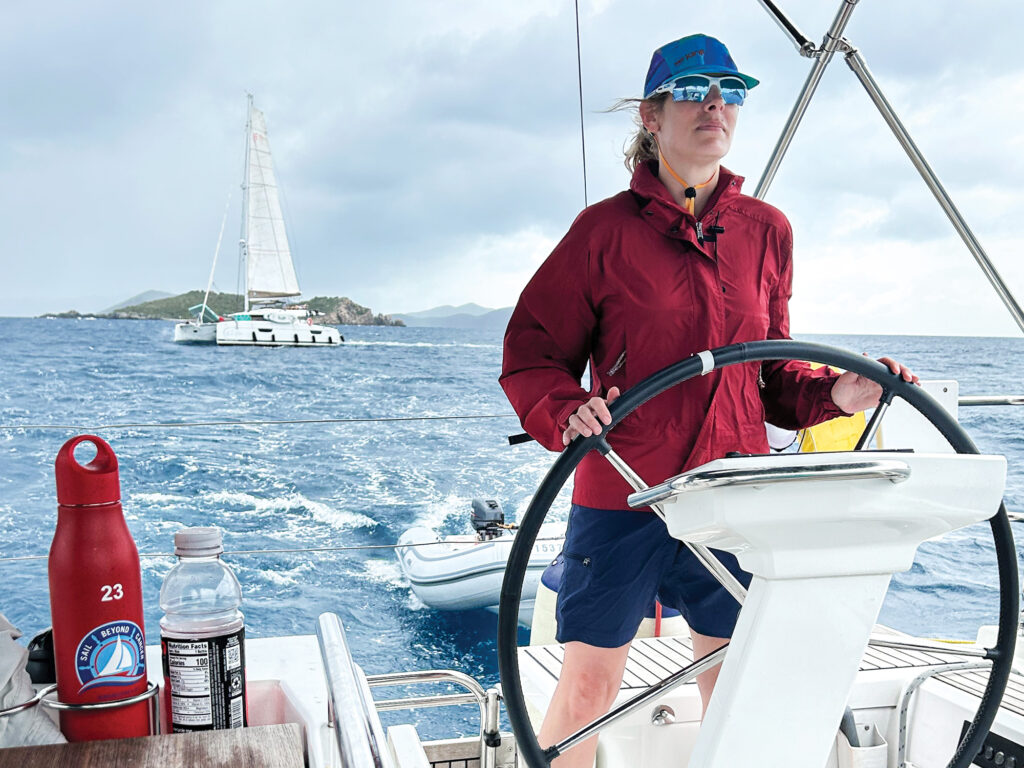
I’m feeling very uncomfortable,” my daughter said, midpassage, as we sailed through the Sir Francis Drake Channel in the British Virgin Islands.
Looking aft, I could see her standing, gripping the wheel, the sea behind her lumpy and tilted, the dinghy bumping along as we beat into the April trade winds.
I said nothing. We were aboard a Moorings 52, a powerful sloop, doing 6 knots as we passed between The Dogs and Virgin Gorda. Dutch, our instructor who sat nearby, spoke to her quietly, repeating steps he’d introduced just two days before. § She pursed her lips and paused. As I watched with admiration, she raised her voice to the crew.
“Ready about.”
Amy Carrier and I were in the third day of a promise made decades before: to teach her to sail. Life had intervened, with 42 years passing since we had lived in the same state. What prompted the trip were two big birthdays: my 80th and her 50th. With the caution that a father ought not to teach his child to drive—or sail—I proposed that we go grand and enroll in Colgate Offshore Sailing School’s Fast Track to Live Aboard Cruising, an intense eight-day course that, if passed, awards US Sailing’s Bareboat Cruising certification.
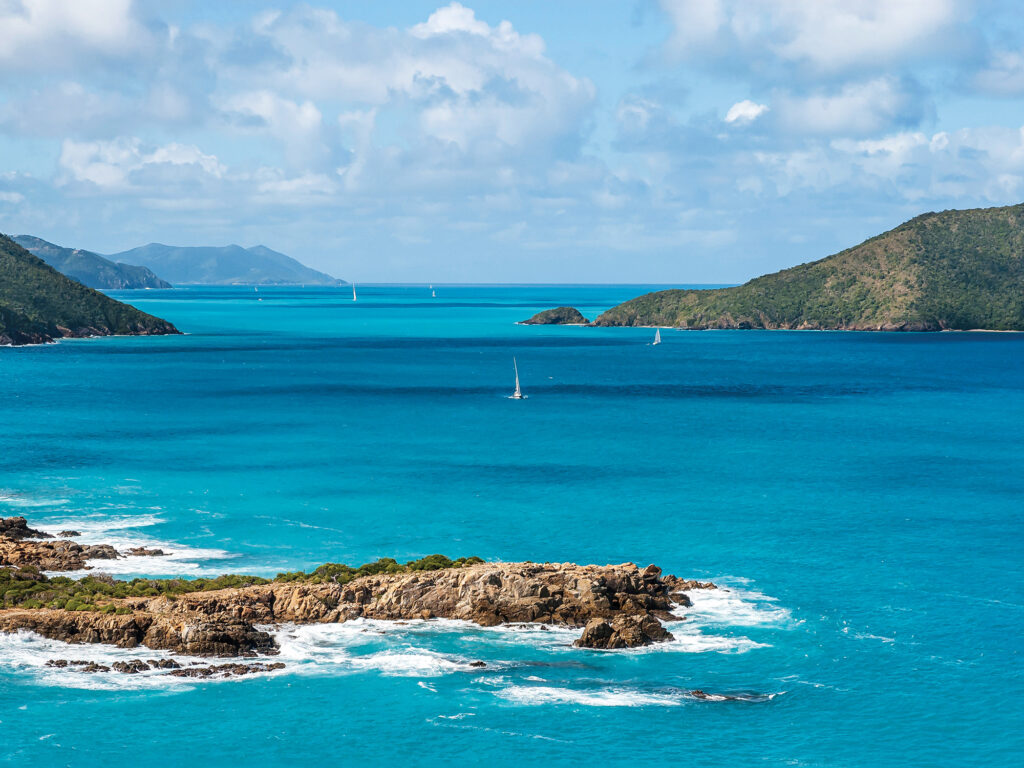
Our resumes were night and day. Amy was a Ph.D. consultant with a wall of degrees. Except for a week on my boat a dozen years before, she was as raw as a sailor could be. Her goal was to charter a boat with her husband.
I had sailed for more than five decades, on and off, starting with a 12-foot Snark, a sailing school in Denver, a bareboat month in the Caribbean, and 15,000 miles on my 35-foot Allied Seabreeze yawl with stops at Key West, Florida, and Montgomery, Alabama, over to Cuba, and then across the Atlantic and Mediterranean.
So, as I flipped through three assigned textbooks during the flight to Tortola, I said to myself, I know all this stuff. My biggest concern, frankly, was a mixed metaphor: feeling like a fifth wheel while biting my tongue.
Joining us in Tortola were Angela and Scott Ness, two 66-year-old Ph.D. cancer researchers from Albuquerque, New Mexico, who had done some Hobie Cat sailing in California’s Long Beach Harbor. Their goal was to bareboat with friends in the BVI when they retired in June.
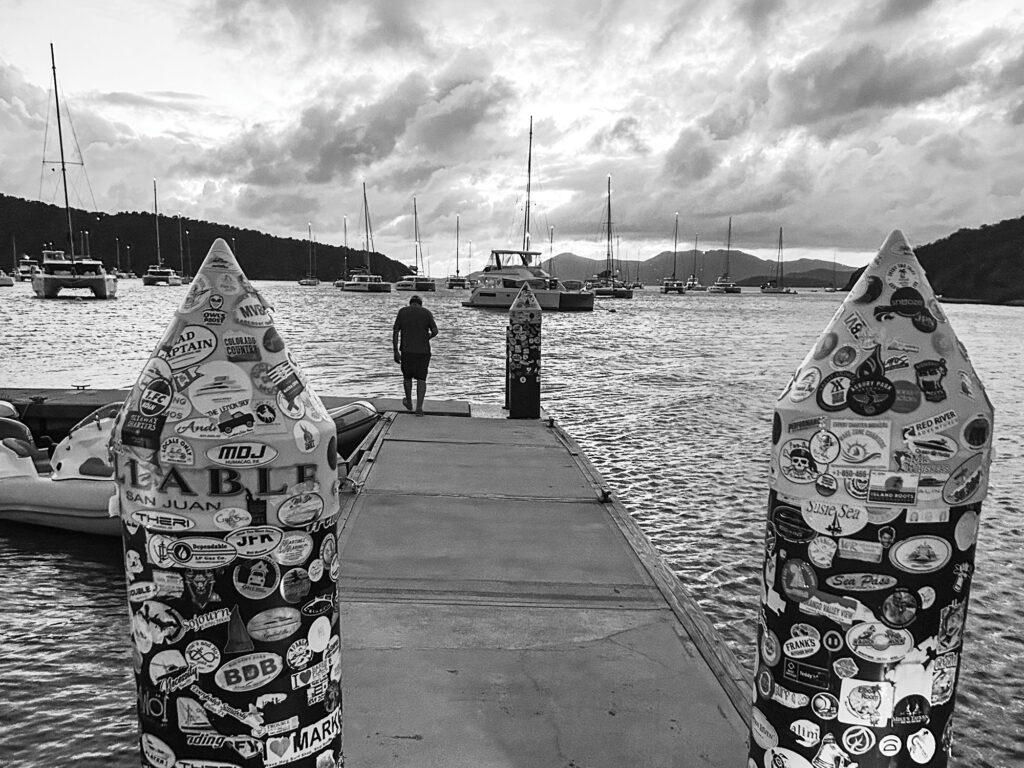
Our instructor for all but the first day was Offshore’s branch manager, Folkert “Dutch” Jongkind, a native of the Netherlands with a ton of experience, including 25 weeks a year leading groups like ours.
Colgate’s course slogan is “From couch to captain in a week.” As we spent the first two mornings of the course in a classroom, I watched my three well-educated colleagues madly scribbling notes, sketching little boats, and labeling parts while I ate birthday cake. We then moved aboard a Colgate 26, a specially designed open sloop with room for the instructor on the stern, and began to put into practice what we had previously learned on the dry-erase board.
Tacking, jibing, running, beating, person overboard, picking up moorings: Seeing all of it shoveled into one week made the details of sailing seem astoundingly granular. Maneuvers that I took for granted, when they were broken down into steps, dwarfed instructions for a houseful of IKEA furniture.
We then moved aboard Glad 2B Here, a sleek monohull with four air-conditioned staterooms, a galley and salon, and twin helms and electric winches. We took the first quiz, and I was mortified as all three shipmates scored 100 while I, the grizzled know-it-all, got 94. That night, I got up at 3 a.m. and crammed for two hours, just like I did in college to squeak out a bachelor’s in psychology.
Sailing with Dad is an origin story for many sailors. One of my favorites is My Old Man and the Sea by David and Daniel Hays. You’re on a boat together, learning not only how to sail, but also life-living skills, passing on wisdom and ways of being in calms and gales and moments of stress just by watching, imitating, osmosis.
Tacking, jibing, running, beating, person overboard, picking up moorings: Seeing all of it shoveled into one week made the details of sailing seem astoundingly granular.
The dreams, the expectations of time with Dad can fall short because they’re weighted with old chafing and might-have-beens. “If you don’t do it right, then there can be judgment, and that is an energy that leads to friction,” Doris Colgate, who heads Offshore, told me. Widely honored for opening the sailing world to women, she said: “Women love to learn with other women because there’s absolutely no judgment involved. Everybody feels they’re on an equal basis, and they’re much more relaxed.”
Women also learn differently, she said. “They want to know what they’re doing and why they should be doing it. When it doesn’t come out, I’m much more willing to say: ‘I don’t get it. Please show me again.’ Most guys wouldn’t do that.”
The worst thing a man can do when things get wild is grab a line or tiller from a woman. “Oh, God, I hate that,” Colgate said. “There’s something called chivalry, and if I see one more coat thrown into a puddle, I think I’ll scream. Even today it happens—even with our instructors. I get on the boat, and they take the helm away. Seriously.”
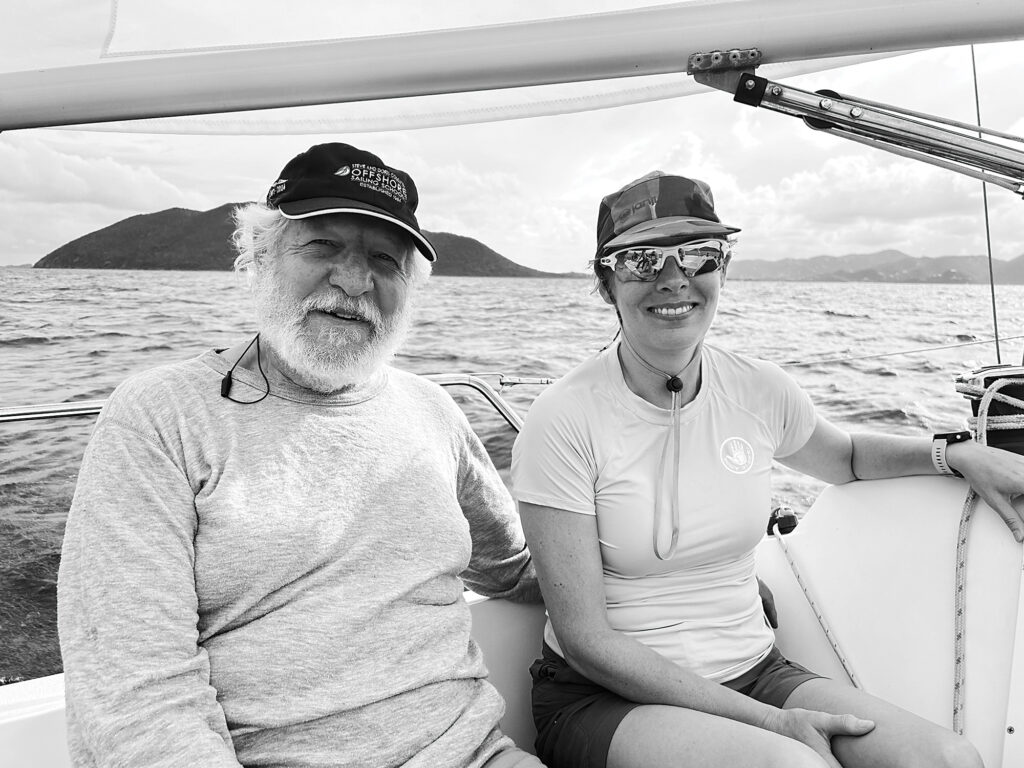
Amy’s mother and I divorced when she was 8, so I missed her growing day to day. I called nearly every night from across the country but often imagined her rolling her eyes at any discipline or wisdom. Our times together were big trips around my work: camping in Yellowstone, boating through the Grand Canyon, rounding up cattle on a ranch.
Even if we had found the time to sail, there was so much to impart. I had learned from millions of waves, hundreds of nights at anchor, decisions good and poor, moments of bliss and beauty. I wanted to teach all that while protecting her from mistakes I’d made.
What I really wished was for her to sit alone in a beadboard Snark with nothing but a daggerboard, tiller and lateen sail, and learn to feel the ballet of sailing. Or time on a J/22, a real sailing boat, feeling the line in her hands, watching telltales and the Windex. Those were the best sailing schools, I felt, if only because that’s how I had learned.
At Colgate, we had a week. I could only watch her try her first jibe, first oversteer. Lines, winches, clutches—it was confusing to her, she later admitted. Moving on to the 52 after two classroom days was, I felt, a leap to meet the minimums. But right beside us was Dutch, whose demeanor projected assurance that you were safe, that you could fail but not fall into trouble.
Dutch also knew the islands, the bars, the restaurants and the best mooring fields, which we sampled. They fueled our drive to get on with learning. For me, the grandeur of the islands was background to the drama of our onboard classroom.
I could feel the anxiety from three high achievers to learn in a week what had taken me four decades. “I thought I knew how to sail,” Scott Ness said afterward. Angela added, “I felt I was on a hockey-stick learning curve.” The week entailed learning a new language, tying new knots, being visibly stressed while tacking the Colgate 26 through a mooring field. “I’m freaking out because I don’t know what the hell I’m doing,” she said. “I was not ready for it.”
By week’s end, we were able to josh about goofs made in front of one another. (That included my fall into the dinghy when my aging knees buckled while climbing onto the dock at Willie T’s—beforeI ordered my first Painkiller.) Through repetition, book learning and teamwork, everyone passed. We had a ticket to rent a bareboat. But all three of my shipmates knew that they needed more time before chartering.
“I learned how to sail,” Amy said when we talked, back in the United States. “I couldn’t have gone sailing by myself before then. I didn’t know all the mechanics of a boat. I didn’t know what to do with sails and all that stuff.”
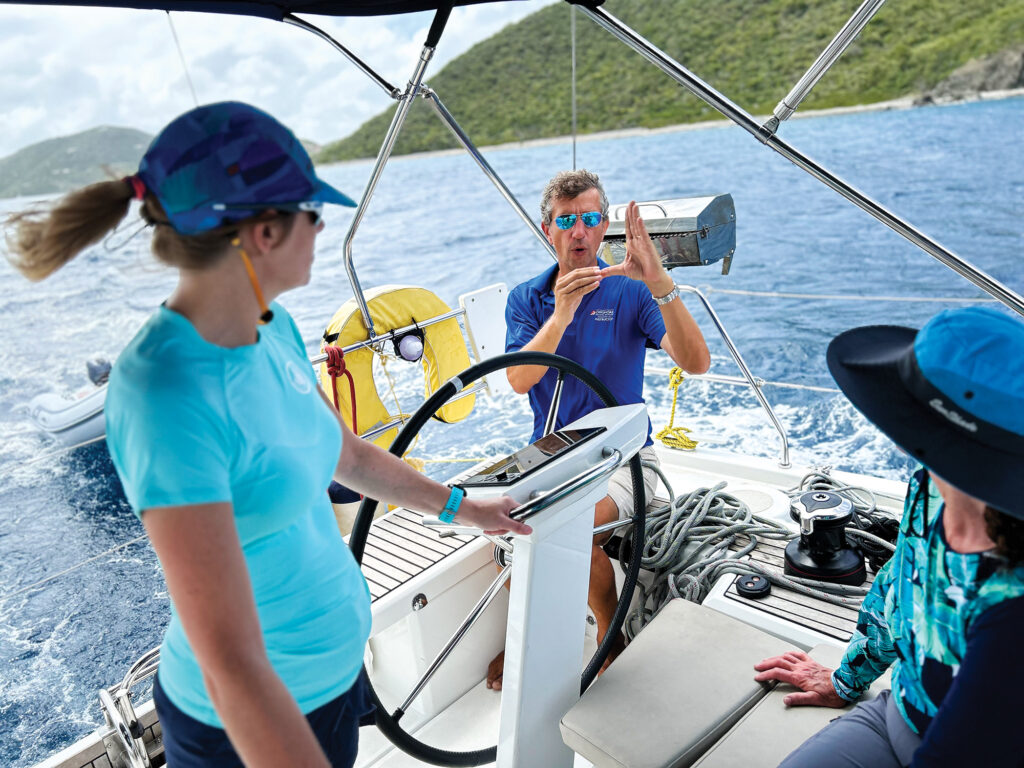
After Dutch showed her the boat’s self-righting design, and how to control it, her fear of heeling dissipated. “I learned a lot,” she said. “It was exhausting. Intense. Am I ready to charter myself or with an unexperienced crew? No. If there was a little sporty boat available, would I take it out? Yeah, probably.”
The graduation certificate for US Sailing’s bareboat cruising course was, in reality, a driver’s license, in Dutch’s view. We knew the rules of the road, but not how to drive in all conditions. His job was to “open the door. A first step to sailing.”
Doris told me: “I always say about sailing, it’s 90 percent bliss and 10 percent terror—and you need terror. You need to be out there at some point where everything’s gone wrong and it’s pretty scary weather. But once you have that education, or you’ve had the years of experience like you have, it’s not alarming. You just buckle down and do what you need to do. And I think that translates into life as well.”
Ultimately, what Amy and the Nesses were learning was this: “They can do anything they want. They are empowered, emboldened,” Colgate said. “It’s a huge confidence-maker when you can make a boat go where you want it to go with wind alone. That’s pretty exciting.”
In our postmortem, Amy and I realized that we had long shared a philosophy imparted by Dutch. If you’re not enjoying it, something’s wrong. You should be able to relax out on the water. “That’s a stance you and I both have taken with jobs and everything else,” Amy said. “If it isn’t fulfilling, if I’m not enjoying it, f-ck it.”
Our last day in paradise, when we were supposed to take out the boat overnight and return it without the instructor, was canceled by a rolling series of fierce thunderstorms. I used the time to reflect. My usual melancholy at leaving Amy was brightened by the vision of her sailing into the morning sun, as I had done so many times. With little inheritance to pass on, I had given her something of me. Searching for the words to describe that gift, I asked Amy what she told her friends.
“I went sailing with my dad.”
A Daughter’s Perspective
Three days before Christmas, I received a text message from my dad: “Got time to talk?”
He informed me that the Offshore Sailing School had spring 2024 availability in its Fast Track to Cruising course in the British Virgin Islands. We immediately had to decide whether to attend because the price would increase at midnight.
I responded with a resounding, “Um, OK?”
Up to that point, our idea of taking a sailing course together was just that: an idea. We had tossed around a few of them: chartering a bareboat in Europe (his proposal), chartering a captained boat in the Caribbean (my suggestion), traveling to Cuba (also mine). All of these were possible answers to the question of how we should celebrate his 80th birthday.
Our conversations seemed like fun dreams until that December day, when I realized just how serious he was.
Dad shared an email from the school’s coordinator with the details. I blanched a little at the cost, as well as at the time we would need to dedicate to this adventure: eight days in the BVI plus at least one more for travel. I had just started a new job.
Luckily for me, my new boss loves to sail. I had dreamed for years of visiting the BVI. I longed to see the white sands of Anegada, the Baths, the Soggy Dollar.
What settled the matter was my acute awareness of the passage of time. I had lost my mother two years prior. She was a far-too-young victim of Alzheimer’s disease whose rapid decline and passing tore my world apart. Dad was turning 80. He exudes good health, but you never know. This was an opportunity for (perhaps) one last big trip together, and for him to share something he loved with me. How on earth could I possibly say no?
I served as travel agent, using miles and points to coordinate our flights from Ohio and Vermont to Miami a day before we had to be there. We were taking no chances. From Miami, we flew to Beef Island together with our duffels and boat shoes, then took a quick taxi to meet the ferry to Scrub Island. Dad chatted with a young couple celebrating their honeymoon and bought them celebratory Coronas as we waited.
The resort was gorgeous, secluded and peaceful. Our rooms overlooked the docks. We could see two of the Colgate 26 keelboats, along with a variety of catamarans and one or two monohulls. Our first evening, we bought cheese and wine from the market and crashed early.
Class started the next day at 8:30 a.m. sharp, but with a surprise: Offshore had arranged a birthday cake for Dad. We, along with two other students, spent a few hours in the classroom before heading out on one of the Colgates. I was relieved to know that I wasn’t the only nervous one on board.
Rain chased us back in, and we had a lazy lunch before repeating the morning’s structure. That evening, we celebrated Dad with dinner and another cake. We begged our classmates to take some back to their room.
Our second day mirrored the first: more classroom, more sailing, and confusion interspersed with flashes of understanding and feeling—for just a moment—like we knew what we were doing. On Day 3, we boarded Good 2B Here, called dibs on staterooms, stowed our gear, and headed out to open-ish sea.
I remember the next few days as a blur. Tacking and jibing, learning to read a chart and use a compass, and understanding the magnetic variation caused by something as small as a smartphone. Stand-on rules and the exceptions, the complexities of the engine and the water system, how and when to use the marine radio. But there was fun too. We took a break one morning to visit the Baths, arriving early and having the park to ourselves. We sailed through sun and sudden downpours, and we threw that poor fender overboard again and again. We made checklists for raising the sails, putting the boat to bed, what lights to turn on at night, and how to use the navigation and sound systems.
Our last night on board, Dad and one of our classmates made dinner: shrimp and pasta accompanied by wine and laughter about our newbie mistakes and our instructors’ endless patience.
Dad and I talked and joked, and snipped at each other when we got tired or frustrated. We’re both hard of hearing, which made the wind and waves an occasional nuisance. We shared memories of our many travels together and wondered aloud what it would be like to come back to the BVI and charter a boat for ourselves. We didn’t make it to Anegada or Soggy Dollar, which is all the more reason to return.
Still, I watched him nap in the midmorning quiet and gave thanks that we had made this choice, that we had taken this time to spend together.
Our last morning, he asked our classmates how they thought we did as father and daughter; he seemed taken aback by the answer: “You have different temperaments.”
Maybe true, but we share a passion for the really cool things we’ve done together. Yes, Dad’s love for sailing was successfully passed down, just as he had hoped. Since then, my husband and I have relocated to Raleigh, North Carolina, and I started researching sailing clubs on the coast. I also persuaded my husband to enroll in the same course in the BVI. I plan to join him there.
Perhaps, to celebrate Dad’s 85th birthday, he and I can charter our own boat and finally make it to Anegada, with a stop at the Soggy Dollar for a well-earned Painkiller. Until then, I’ll treasure the memories of our week together and look forward to the next text I receive that asks, “Got time to talk?” —Amy Carrier
The post Passing the Tiller appeared first on Cruising World.

